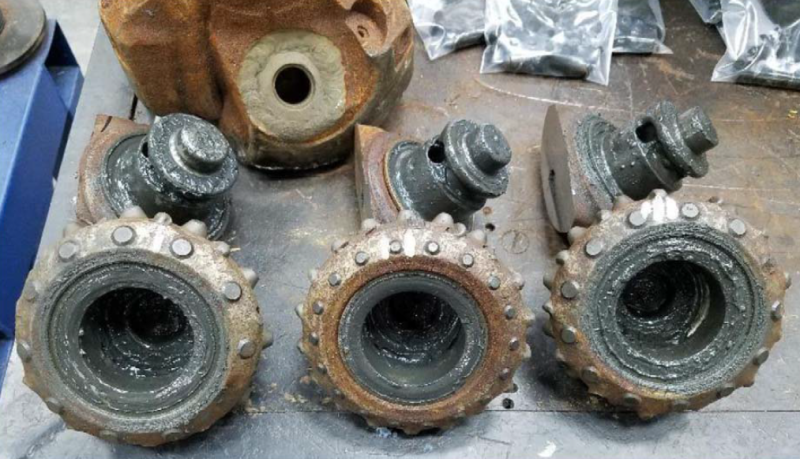One of the hottest wells ever was drilled last year in Iceland, with a bit and mud motor from Baker Hughes surviving in a well surrounded by rock as hot as 426ºC (static temperature).
It was the second attempt to drill a really deep geothermal well after the first abruptly ended half way to its target depth. In fairness to the hardware, it worked right up until it drilled into the magma. It is now displayed in a museum run by HS Orka, a consortium of Icelandic energy companies formed for the project.
“We were able to pump water until the magma let it go,” said Ari Stefánsson, power plant manager for HS Orka, who was the drilling manager for the project covered in a paper delivered this week at the IADC/SPE Drilling Conference in Fort Worth, Texas (SPE 189677).
The website for the Icelandic Deep Drilling Project said that after the “molten rock was rapidly quenched” there was 20 m of “obsidian glass” at the bottom of the 2,100 m hole.
Six years later, a second well was drilled using a specially designed drill bit and motor built to survive temperatures up to 300ºC. The rated temperature limit is more than 50% higher than the current maximum for extreme temperature equipment, and double the level for most downhole equipment, said Ralf Duerholt, a technical advisor for Baker Hughes in charge of that work.
The first well showed it is possible to drill down to the lava using available hardware cooled by drilling fluid. But such extreme conditions cause early equipment failures increasing the cost and time needed for drilling in the hottest depths that can deliver the most energy.
The equipment development was partially paid for with grants totalling $10 million from the US Department of Energy. It wants to fill a gap in geothermal drilling equipment that has held back development of a potentially huge energy source. The project in Iceland was the first chance to drill with it.
The rock is basalt, a tough, fractured obstacle. For that reason, Baker Hughes built a rotary cone bit for its ability to stand up to the hard rock. That meant more moving parts than a simple PDC bit, which has diamond-tipped cutting teeth and does not require seals or lubrication systems, but presented a greater risk of damage without careful use, Duerholt said.
As for why they are trying to get so near the magma and its extreme heat, it is because that is where the energy is.
By getting to the bottom of a well twice as deep as the typical geothermal well, HS Orka tapped a source of electric power that is 5-10-times greater, Stefansson said. That is enough steam to generate up to 220GWh of electricity to 440GWh of electricity per year from a natural source that is always on.
One of the limits of using geothermal has been drilling the number of wells needed, which require reliable data from measurement while drilling (MWD) equipment to navigate near chambers holding molten lava. The driller must also create a pair of nearby horizontal wells, one to inject water into the fractured rock and a second to produce the steam produced.

The Icelandic project showed that it is possible to build an effective drill bit and a mud motor, which is in a curved casing for turning, and the third well planned for early 2019 will test the MWD equipment, which recently was qualified for drilling. That is a critical piece of the system needed for the directional drilling required to generate the steam needed to drive a power plant.
That temperature specification goes well beyond what is needed in the most extreme oil wells planned, but it could provide more reliable drilling alternatives, said Duerholt.
During the 168 days of drilling, Orka worked through a series of drilling obstacles including periods of lost circulation when it encountered large fractures. That added drilling days, but in a well that hot there is a small upside, all the fluid pumped to deal with those losses did cool things.
The cooling effect of the fluid flowing from the surface was greater than expected in the second well, holding them below the 300ºC maximum rated temperature.
Extended periods of extreme heat near the bottom of the nearly 4,700 m well required some big changes. The limit of the elastomers used for seals is around 200ºC, so they were replaced by parts machined so precisely they could form metal-to-metal seams. Moving parts were lubricated by grease designed to survive those extreme conditions as well as specially formulated drilling fluids.
There are electronic components made of materials that raised the maximum operating temperature, but the limit was still far short of what was needed. Tool builders isolated them within an insulated capsule surrounded by a water-filled container that gradually boiled with steam going into a second container. The change of state absorbed heat, holding the temperature inside to 175ºC or less during the qualification testing.
When in a spot where the temperature is 300ºC, the MWD system can stay cool enough to avoid damage for 50 hr. In conditions where the temperature is not so high, it can run longer, Duerholt said. Its commercial future will depend on whether the payoff for longer-lived equipment justifies the added cost of making this high-performance equipment.
The longest run for the bit was 467 m. While the heat lessened the effectiveness of the metal-to-metal connections, it performed up to expectations as did the redesigned lubrication system.
Now Orka is trying to figure out how to complete the one they have. The superheated steam is also acidic, which could corrode pipe—keeping it in a super-critical state should reduce the damage it causes—and planning the next well needed to create this huge underground heat exchange system.


